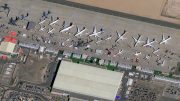The battle of figures is in full swing. While the Dubai Airshow opened on record orders from the two major global players Boeing and Airbus (the latter finally receiving its first order for 50 A380s in 2013), other manufacturers are lagging behind.
It is true that the Middle East is not its preferred market, but one can’t help but note Chinese Comac’s absence this week in Dubai, even though its partner Avic and almost all its subsidiaries are present. Rumours had been circulating since the summer – confirmed in the autumn – that the Chinese C919 aircraft is now at least a year behind schedule which means that its first flight, due to take place in June 2014, might be pushed back to late 2015.
Comac announced it has finalised 95% of its detailed design, one year after completing the pre-design in September 2012.
So what’s going on? Will this aircraft finally be delayed as much as the regional aircraft ARJ21? The fact remains that this does not make Chinese investors lose faith in their national manufacturer, as witness the order received by Comac in late October for 20 aircraft from the leasing subsidiary of the Chinese financial institution Industrial Bank Co. A very welcome order indeed, since it allows Comac to reach the 400 aircraft mark…, although very far from the 10,000 orders announced at the same date by Airbus for its A320 family. The path is still a long one for the Chinese, but this new test run will succeed in bringing this potential competitor to the forefront especially since, from the outset, Comac partnered up with Western industrialists who, although suffering from the current
delay in the programme, should at some point obtain a return on investment.
This has been managed in most cases via partnerships because China wishes to constitute a veritable equipment making industry. And, just as the Airbus final assembly line in Tianjin required the creation of a joint venture between Airbus’s Chinese subsidiary and a consortium of Chinese companies and organisations, so a large number of Western industrialists were obliged to set up a joint venture in order to participate in the C919.
It is the case for instance of the American companies Rockwell Collins (communication and
navigation systems), UTC Aerospace Systems, including Hamilton Sundstrand (electrical generation), and Parker Aerospace (actuators for primary flight controls, hydraulic and inerting systems), which have signed four JV agreements with subsidiaries of Avic. The Franco-American Nexcelle (Aircelle and MRAS) has done likewise, still with the Avic Group, to produce elements of nacelle in mainland China, while Liebherr Aerospace, whose French and German factories have both been engaged – for air management systems and anti-icing fluids in the case the former and landing gear for the latter (both systems that theToulouse OEM already supplies for regional aircraft ARJ21) -, has also set up a joint venture with LAMC, one of Avic’s subsidiaries.
Other manufacturers have also been forced to take the leap into onsite joint venturing.
This is the case for GE Aviation Systems (for avionics) and more generally for the GE and Safran umbrella groups that are already well established in China. Of course sometimes industrialists are reluctant to transfer too much know-how. Engine manufacturer CFM International, whose Leap-1C engine was selected for the C919, and its two shareholders GE and Snecma (Safran group) believe that a final assembly line might give away too many technological subtleties. Therefore, although there is an agreement in principle to study the possible installation of a final assembly line for the engine in China, CFMI does not yet feel ready because, aside from reasons of industrial protection, CFMI considered in July that 380 firm orders were insufficient to justify such an investment. It is by no means sure that the 20 additional aircraft will change their minds. Especially given the announced delays which put a strain not only on the engine manufacturer, but on the entire supply chain, which will have to wait a while longer before recouping their investments.
Nicole Beauclair for Aeromorning










Be the first to comment on "Heavy toll for the partners of the C919"